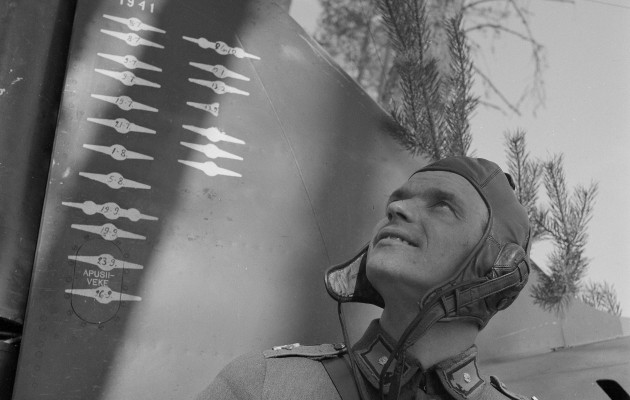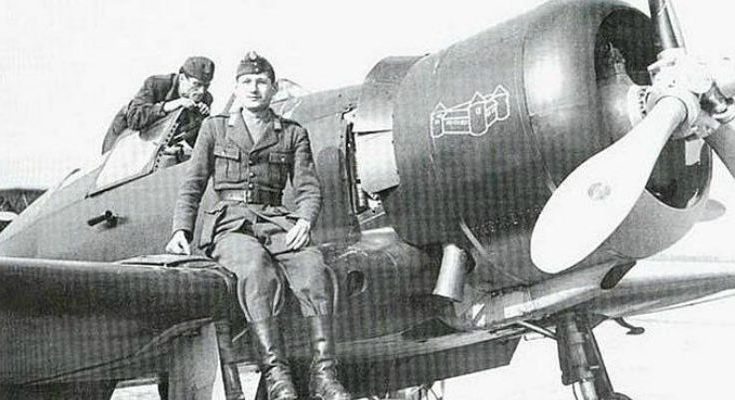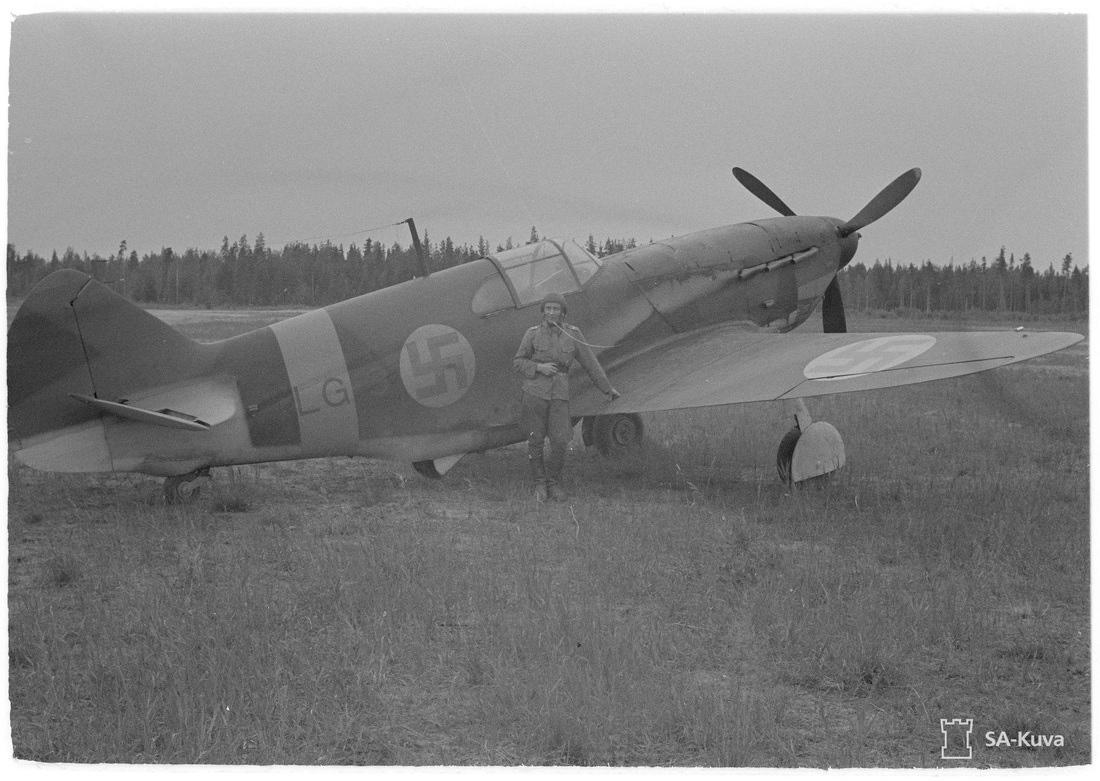4. Fighter Wing (Major Franjo Dzal)
10. Fighter Squadron
11. Fighter Squadron
The 4. Fighter Wing was attached to the Jagdgeschwader 52 . It originally served as part of the III./JG 52 , while later it became known as the 15(Kroat.)/JG52 . It was led by Franjo Džal .
5. Bomber Wing
12. Bomber Squadron
13. Bomber Squadron
The 5. Bomber Wing was originally attached to Kampfgeschwader 3 as part of the 10/KG3 and later as the 15.(Kroat.)/KG 3 .
Fighter operations over the Eastern Front 1941-44
Croatian Pilot Mato Dukovac, in front of his Messerschmitt 109 G fighter on the Eastern Front, 1942. He was the top-scoring Ace of the Croatian Air Force Legion with 44 confirmed victories against the Soviet Air Force. Note the Legion's crest below the aircraft cockpit.
One squadron of the Fighter Wing was sent to the area of Furth , Germany, for training, the other to Herzogenaurach Airfield, nearby. Training commenced on July 19, 1941, on Arado 96 and Messerschmitt 109 D aircraft, and lasted to the end of September 1941 at which time the Legionnaires were deemed ready for the Eastern Front and were equipped with various models of the Messerschmitt 109 fighter. During the course of their training, the men had been issued Luftwaffe uniforms adorned with the Croatian armshield and the Croatian Airforce Legion badge on the right breast pocket.
The Squadron received the official designation '15.(Kroatische)/JG 52', and arrived to its first Eastern Front airfield on October 6, 1941, near Poltava. On 9 October 1941, the Squadron has its first taste of action, when, in the Ahtijevka-Krasnograd area, a Soviet R10 was shot down. The kill was given to the German liaison pilot to the Squadron, Lt. Baumgarten. The Squadron was transferred at the end of October 1941 to Taganrog, and stayed in this area till 1 December 1941. The first kill by a Croatian pilot occurred in this time period by Captain Ferencina, and the second by Lt.Colonel Dzal.
On 1 December 1941, the Squadron transferred to Marinpol. Attacks were made on Soviet armoured columns around Pokorovskoje, Matvejeva, Kurgan, Jeiska and Uspenskoje, and on the railway line Marinpol-Stalino. As well, the Squadron escorted German bombers on their missions. By the end of January 1942, the Squadron had shot down 23 Soviet airplanes (of this, four were MIG-3 fighters).
At the end of March 1942, the Squadron received a telegrams from the Commander of 4.Fliegerkorp, General Flugbeil, and the Commander of 4.Luftflotte, Colonel-General Lohr, congratulating them on their successes. In April 1942, the Squadron flew escort missions for Stuka bombers, guarded the Marinpol airfield, and strafed Soviet troops in the Azov Sea area. Nine more Soviet airplanes were shot down in this period.
In May, the Squadron was transferred first to the Crimea, and shortly thereafter, to the Artemovka-Konstantinovka region. From this base of operation, the Squadron flew escort missions for bombers attacking Sevastopol and patrolled the Azov Sea area. Four more Soviet planes were downed, and a Soviet patrol boat was also sunk. From the end of May, till 21 June 1942 (the date of the Squadron's 1000 flight), 21 more Soviet planes were shot down. From this date till the end of July 1942, 69 more aircraft are shot down.
At the end of 1942 the unit was given a three-month rest, returning to Nikolayev on 21 February 1943. Although the unit continued to score kills, there was a spate in defections from 15./JG 52, with pilots flying to Soviet airfields. The remaining pilots were questioned by the Luftwaffe, the Staffel was withdrawn from the front, and the commander of the HZL was replaced. This was the end of the second tour of 15./JG 52 on the Eastern Front.
The Luftwaffe decided to replace most of the remaining pilots of 15./JG 52 with newly trained men, and several veterans of the Staffel joined them during their fighter training at Fürth. Twelve graduated on 1 October 1943 and they arrived with two other pilots at Nikolayev on 21 October 1943, where they were equipped with eight Bf 109G-4s and G-6s. They deployed to their airfield at Bagerovo and commenced combat missions on 26 October. By late 1943 the Squadron had tallied 283 kills, and had 14 pilots who had gained Flying ace status.
The Squadron continued with its fine performances until March 1944 when the Luftwaffe decided that attempting to maintain 15./JG 52 was futile, and the men were sent home to the NDH to help to combat the increasing air activity over the Balkans by the Allies . During its three tours, the Staffel had accounted for a total of 297 Soviet aircraft when it was re-deployed to Croatia.
At least part of the unit returned to the Eastern Front when, at the beginning of July, the Luftwaffe reconsidered its decision. They were transported to Romania and then the Slovak Republic, but no aircraft were provided, and on 21 July the pilots were advised that the HZL was to be disbanded. Despite this, in August they were moved to an airfield in East Prussia, where they took delivery of ten Bf 109G-14s. At the beginning of September they flew to Lithuania in preparation to rejoin the fray, but the defection of squadron leader Mato Dukovac led to the cessation of Croat aerial operations on the Eastern Front.

Bomber operations over the Eastern Front 1941-42
Officially designated '15.(Kroatische)/KG 53'., the bomber squadron was equipped with Dornier Do 17 Z aircraft. It arrived on the Eastern Front on 25 October 1941, after training at the Grosse Kampfflieger Schule 3, in Greifswald, Germany. Their first area of operations was near Vitebsk. The rest of the Bomber Squadron's assignments were in the Northern Sector of the Eastern Front, including the bombing of Leningrad and Moscow. On 9 November 1941, the Squadron was congratulated by Fieldmarshall Kesselring for its actions thus far. After flying some 1,500 sorties on the Eastern Front, the Squadron and its aircraft were re-deployed to Croatia in December 1942, to help combat the growing Partisan threat to the Axis forces in occupied Yugoslavia.
Fighter operations over Croatia 1944-45
In early 1944 the squadron was redesignated 1./(Kroat.)JG but remained in the Crimea on the Eastern Front. Around the same time two new units were formed to defend the airspace over Croatia. The crews for 2. u. 3. Staffel were drawn from Croatian pilots who had recently completed an A/B course at a German flight school in Bohemia followed by a Bf 109 fighter school in France.
They returned to Croatia in early January 1944 and were assigned to Velika Gorica where the two Staffeln were to be formed. Plans to outfit the Staffeln with Bf 109s were canceled, and at the end of January the pilots of the 2. Staffel ( 2./(Kroat.)JG ) went to Italy to collect around a dozen Macchi C.202s and Fiat G.50s. The 3. Staffel was an operational training squadron, also known as 3./(Kroat.)JG and equipped with Macchi C.200 and Fiat CR.42 fighters. All these aircraft retained their Luftwaffe markings whilst in service with the unit.
After a period of operational conversion, the squadrons commenced operations against the frequent incursions over Croatia by USAAF and RAF aircraft. By April 1944 1./(Kroat.)JG ahd been withdrawn from the Eastern Front and its crew returned to NDH. During a period of intensive activity over the summer of 1944, the squadrons claimed some 20 Allied aircraft shot down, while at the same time receiving further Macchi C.202s , as well as several brand new Macchi C.205s.
By the end of 1944 the squadrons had handed in their remaining worn-out Macchis for brand new German Messerschmitt 109 G & K fighters. Over 50 Messerschmitts were delivered to the squadrons and the Air Force of the Independent State of Croatia , with the final delivery taking place on 23 April 1945.
Bomber operations over Croatia 1943-45
Upon its return the Legion's bomber squadron was redesignated 1./(Kroat.)KG after having flown its nine Dornier Do 17 Z bombers from Russia back to Croatia. The Dorniers proved a welcome addition to the strike power of the Axis forces fighting the Partisans in occupied Yugoslavia right up to the end of July 1944, when it was incorporated into the ZNDH. In late 1943, a second squadron, 2./(Kroat.)KG was formed to provide operational training. It was equipped with Italian designed and built CANT Z.1007 and Fiat BR.20 bombers.



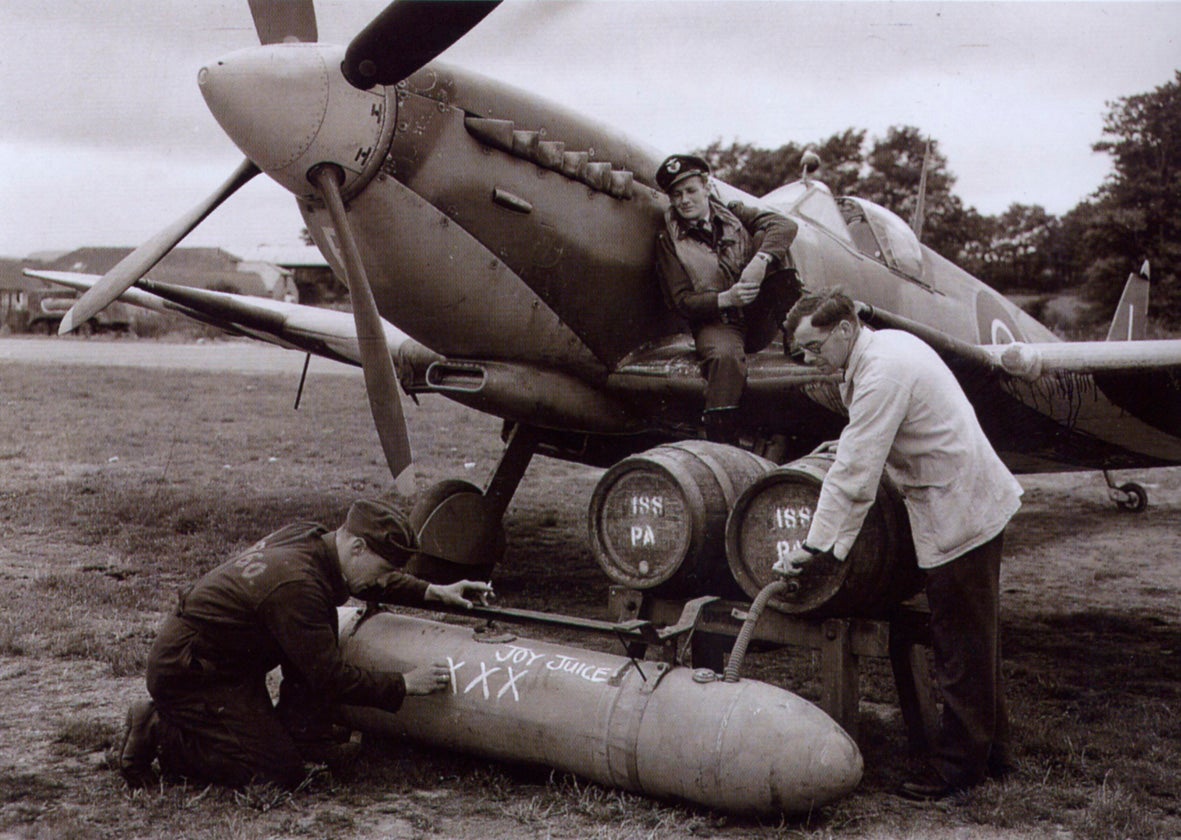


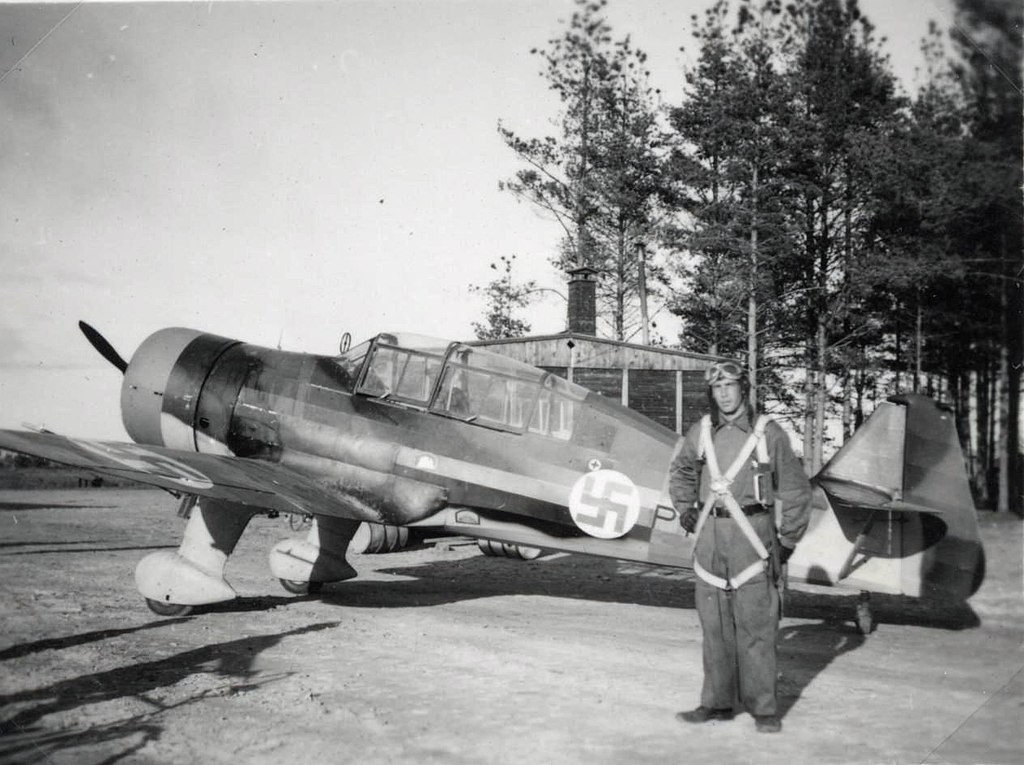




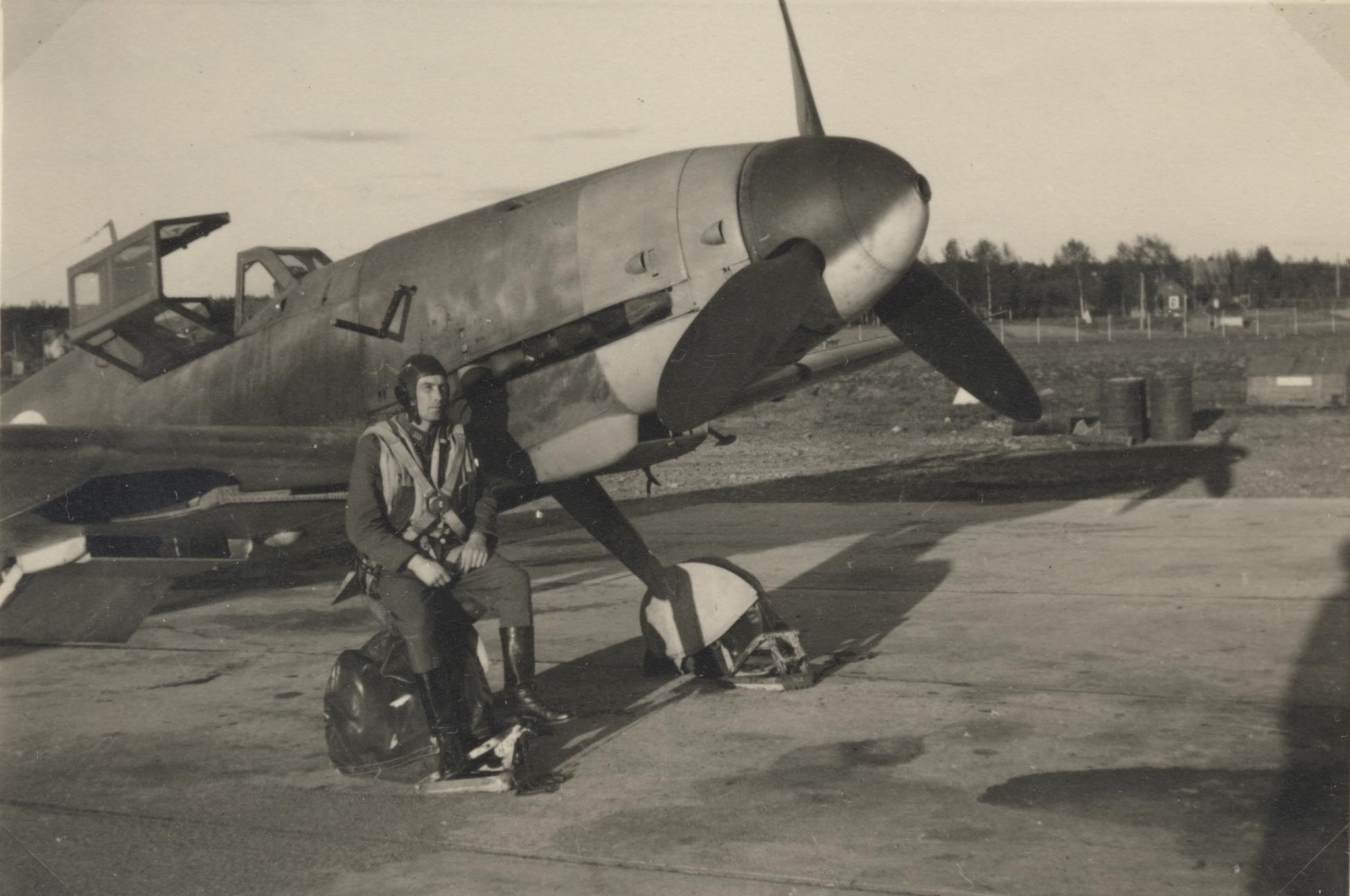








![Kuvahaun tulos haulle Lauri Nissinen Born 31 July 1918 Joensuu Died 17 June 1944 (aged 25) Kaukjärvi Allegiance Finland Service/ branch Finnish Air Force Years of service 1939–1944 Battles/wars World War II Winter War Continuation War Lauri Nissinen (31 July 1918 in Joensuu – 17 June 1944 in Kaukjärvi ) was a World War II flying ace in the Finnish Air Force . [1] Contents 1 Biography 2 See also 3 References 4 External links Biography [ edit ] Nissinen achieved 22 of his victories while piloting a Brewster B-239 Lauri Vilhelm Nissinen was born in Joensuu on 31 July 1918 and for his compulsory military service joined the Air Force, during which time he decided on flying as a career, applying for NCO pilot training in 1938. Due to his performance during training he joined HLeLv 24, flying the Fokker D.XXI in May 1939. In summer 1939 he was promoted to Sergeant. As the Winter War broke out, Sgt. Nissinen first claimed an air victory on 1 December 1939, claiming a SB-2 shot down and damaging two others over Viipuri . By the end of the Winter War he had claimed four victories in total and was a Sergeant Major. HLeLv 24 then equipped with the US- built Brewster Buffalo . As hostilities broke out again on 25 June 1941 Nissinen again flew operationally. On 7 July 1941 over Käkisalmi two enemy fighters attacked head-on, Nissinen shooting down both. On 21 July 1941 he again shot down a I-153 in a head-on battle, although his aircraft was damaged and he returned to base. His ground crew found four hits in the engine, one in the prop and several more in the wings. On 1 August 1941 at Rautjärvi six Buffalos engaged eight Soviet I-16 fighters, Nissinen's target exploding and its debris damaged Nissinen's right wing. Three I-16s attacked from behind and his fighter took several hits, shattering the windscreen. At the end of 1941 Nissinen was the second highest scoring FAF ace with 15.5 kills. Early in 1942 Nissinen attended Officer Cadet School, from where he then graduated in June 1943 as a Lieutenant. Nissinen was awarded the Mannerheim Cross on 5 July 1942, his number being 69. He held the rank of vänrikki at the time. [2] Returning to HLeLv 24 Nissinen was made a flight commander and resumed flying missions. His score increased to 26 by the end of 1943. The squadron gradually re-equipped with Messerschmitt Bf 109 fighters in spring 1944. In May 1944 HLeLv 32, flying the Curtiss P-36, was temporarily strengthened with a Messerschmitt Bf 109G-2 flight commanded by Lt. Nissinen. On 16 May Nissinen scrambled against a single Lavochkin La-5 approaching Nurmoila . The La-5 circled at 1500 m and allowed Nissinen climb to the same altitude before turning to attack from above, shooting down the La-5 after a series of exhausting attacks. With the renewed Soviet offensive on 9 June 1944 Lt. Nissinen scored two more victories on 17 June 1944 as two flights intercepted Soviet Il-2 ground attack aircraft attacking Finnish positions at Kaukjärvi . Nissinen's wingman, Sgt. Heimo Lampi saw the crippled Messerschmitt of Lt. Sarjamo dive through the cloud and collide with Nissinen's plane. Both planes exploded on impact and the pilots were killed. Nissinen flew some 300 missions and scored 32 victories in total. [3] His grave is in Valkeala . See also [ edit ] Finland portal List of World War II flying aces List of World War II aces from Finland References [ edit ] Jump up ^ Lauri "Lapra" Nissinen Archived 2009-10-15 at the Wayback Machine . Jump up ^ Hurmerinta, Ilmari; Viitanen, Jukka, eds. (1994). Suomen puolesta: Mannerheim-ristin ritarit 1941–1945 [ For Finland: Knights of the Mannerheim Cross 1941–1945 ] (in Finnish). Ajatus. p. 253. ISBN 951-9440-28-3 . Jump up ^ Stenman, Kari (2000). "Lauri Nissinen, Mannerheim-ristin ritari 69" [Lauri Nissinen, Knight of the Mannerheim Cross 69]. Suomen ilmailuhistoriallinen lehti (in Finnish) (1): 11. External links [ edit ] Lauri Nissinen at Sci.fi Categories : 1918 births 1944 deaths Finnish aviators Winter War pilots Finnish World War II flying aces Finnish military personnel killed in World War II Aviators killed in aviation accidents or incidents People from Joensuu Knights of the Mannerheim Cross Navigation menu Not logged in Talk Contributions Create account Log in Article Talk Read Edit View history Search Search Wikipedia Go Main page Contents Featured content Current events Random article Donate to Wikipedia Wikipedia store Interaction Help About Wikipedia Community portal Recent changes Contact page Tools What links here Related changes Upload file Special pages Permanent link Page information Wikidata item Cite this page Print/export Create a book Download as PDF Printable version Languages í•œêµì–´ Suomi Edit links This page was last edited on 2 February 2018, at 03:14 (UTC) . Text is available under the Creative Commons Attribution-ShareAlike License ; additional terms may apply. By using this site, you agree to the Terms of Use and Privacy Policy . Wikipedia® is a registered trademark of the Wikimedia Foundation, Inc. , a non-profit organization. Privacy policy About Wikipedia Disclaimers Contact Wikipedia Developers Cookie statement Mobile view](https://upload.wikimedia.org/wikipedia/commons/9/93/Lauri_Vilhelm_Nissinen.jpg)



